|
|
|
Sort Order |
|
|
|
Items / Page
|
|
|
|
|
|
|
| Srl | Item |
| 1 |
ID:
122547
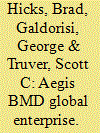

|
|
|
|
|
| Publication |
2012.
|
| Summary/Abstract |
For more than three decades, beginning soon after the end of World War II, the
United States and the Soviet Union faced off against each other. The concept
of "mutual assured destruction"-MAD, the U.S. threat of massive retaliation
to a Soviet first strike-became America's Cold War de facto strategic defense
policy. In March 1983, however, President Ronald Reagan asked whether ballistic
missiles could be destroyed before they reached the United States or its allies,
thus catalyzing efforts for a national ballistic-missile-defense program that would
undermine the need for MAD. That same year, the U.S. N avy commissioned USS
Ticonderoga (CG 47), the first of what is to become a fleet of more than eighty
Aegis warships. In 2012, these trends have converged, and Aegis ballistic-missile
defense (BMD) is an increasingly important component of a robust national
BMD System (BMDS).
|
|
|
|
|
|
|
|
|
|
|
|
|
|
|
|
| 2 |
ID:
122551
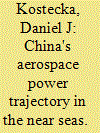

|
|
|
|
|
| Publication |
2012.
|
| Summary/Abstract |
Air and aerospace power has been fundamental for defending China's "near
seas"-encompassing the Bohai Gulf, the Yellow Sea, and the East and South
China Seas-since the founding of the People's Republic.1
While air and naval
operations did not play a significant role in the Chinese Civil War, which was
won by the People's Liberation Army (PLA), the victorious Communist forces
were threatened immediately by hostile air and naval forces from the maritime
sphere. In 1949 the regime was ill equipped to defend its eleven thousand miles
of coastline and more than six thousand islands against attacks and harassment
from Nationalist Chinese air and naval forces occupying the large islands of Taiwan and Hainan, as well as
several smaller islands, let alone protect the People's
Republic of China (PRC) against the aircraft carriers of
the powerful U.S. Seventh Fleet. Even before the People's Republic was officially declared in October 1949,
communist leaders immediately recognized the need
for strong naval and air forces; the PLA's commander,
General Zhu De, stated in April 1949 that China "must
build its own air forces and navy in order to boost
national defense."2
|
|
|
|
|
|
|
|
|
|
|
|
|
|
|
|
| 3 |
ID:
122548
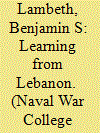

|
|
|
|
|
| Publication |
2012.
|
| Summary/Abstract |
From 12 July until 15 August 2006, the Israel Defense Forces (IDF) waged a
thirty-four-day war against the Iranian terrorist proxy organization Hezbollah
in response to a well-planned raid by a team of Hezbollah combatants from
southern Lebanon into northern Israel. That raid resulted in the abduction of
two IDF soldiers, who had then been taken back into Lebanon for use as hostages.1
Code-named Operation CHANGE OF DIRECTION, the greatly escalated
counteroffensive that the raid prompted has since been widely regarded as the
IDF's most inconclusive combat performance in Israel's history. Waged under
the direction of Prime Minister Ehud Olmert and his minister of defense at the
time, Amir Peretz, the campaign was dominated by precision standoff attacks
by the Israel Air Force (IAF) and by IDF artillery and battlefield rockets, with
no significant commitment of conventional ground troops until the last days of
fighting before a cease-fire went into effect.
|
|
|
|
|
|
|
|
|
|
|
|
|
|
|
|
| 4 |
ID:
122545
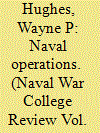

|
|
|
|
|
| Publication |
2012.
|
| Summary/Abstract |
Today's American navy writes prolifically about maritime strategies but has
not devoted equal attention to campaign plans or analysis that tests the strategies' viability. We illustrate herein how the operational-or campaign-level
links policy and strategy to the tactical and technological elements of war at sea.
First, we relate how the U.S. Navy reluctantly came to accept the existence of an
operational level of warfare but having done so will find it useful. Second, we describe important properties of naval operations in terms of constants, trends, and
variables in warfare at and from the sea. Third, we demonstrate how operationallevel planning would help if the Navy and the nation were to adopt six clearly
stated, twenty-first-century strategies that would serve present and future national policies better than do current strategy documents.
|
|
|
|
|
|
|
|
|
|
|
|
|
|
|
|
| 5 |
ID:
122552


|
|
|
|
|
| Publication |
2012.
|
| Summary/Abstract |
The U.S. Navy has an integrity problem in the ranks of its commanding officers (COs). Consider these headlines: "Cruiser CO Relieved for 'Cruelty.'"1
"CO Fired, Charged with Solicitation."2
"CO of Attack Sub Fired for 'Drunkenness.'"3
These are just a few cases in a recent deluge of early reliefs of "skippers."
In 2010, twenty-three Navy COs were relieved of command and "detached for
cause," an enormous increase over previous years. The trend continues: twentyone commanding officers were fired in 2011 as of the end of October.4
Even more
worrisome is the fact that a large and increasing percentage of those dismissals
are due to personal misconduct, such as sexual harassment, drunkenness, and
fraternization. Although (as far as we can tell) over 97 percent of the Navy's
commanding officers conduct themselves honorably, the increasing number of
those who do not raises concerns that the Navy must address. Alarms should be
sounding at the highest levels of Navy leadership, but
a review of recent literature reveals only a trickle of
discussion on the subject of personal misconduct by
military commanders. Instead of calling the service to
action, a Navy spokesman said in January 2011 that
there was "no indication that the reliefs are the result
of any systemic problem."5
|
|
|
|
|
|
|
|
|
|
|
|
|
|
|
|
| 6 |
ID:
122546
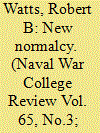

|
|
|
|
|
| Publication |
2012.
|
| Summary/Abstract |
In September 1994, the Caribbean nation of Haiti burst into political unrest that
drove twenty-six thousand migrants out to sea on board overcrowded and unseaworthy craft in an unprecedented mass migration to the United States. Several
months later, over thirty thousand Cubans followed suit, attempting to reach the
mainland on literally anything that could float. On 31 August 2005, a "weapon of
mass destruction" in the form of a category-five hurricane exploded in the Gulf
coast city of New Orleans, killing over 1,300 citizens and forcing the evacuation
of tens of thousands. Finally, on 20 April 2010, the Deepwater Horizon exploratory oil rig exploded, heralding an unprecedented environmental disaster whose
final impact has yet to be determined.
|
|
|
|
|
|
|
|
|
|
|
|
|
|
|
|
| 7 |
ID:
122550


|
|
|
|
|
| Publication |
2012.
|
| Summary/Abstract |
In October 2006 General Charles Wald, Deputy Commander U.S. European Command, brought "Phase Zero" into the joint lexicon with the publication of an
article, "The Phase Zero Campaign."1
Over the last five years the concept of taking
coordinated action in peacetime to affect the strategic environment has become
widely accepted and is now integrated into theater campaign plans. These activities focus on building capacity of partners and influencing potential adversaries
to avoid war. In contrast, Chinese strategic culture has encouraged taking actions
to defeat an enemy prior to the onset of hostilities for two and a half millennia.
This accounts, in part, for the manner in which the People's Republic of China
(PRC) applies the elements of national power in the steady-state environment to
advance its strategic interests. While the United States remains focused on preparing the environment and building partners, Chinese strategic culture states a
preference for defeating an adversary before what Western thought thinks of as
war has begun. This outlook ultimately places the PRC in a position of strategic
advantage. To meet future challenges like that posed by the PRC, the United
States should better integrate Phase Zero with contingency (crisis) planning, then
design and execute operations in the steady-state environment that go beyond
avoiding war and attempt to settle conflicts in accordance with the national interests of the United States.
|
|
|
|
|
|
|
|
|
|
|
|
|
|
|
|
|
|
|
|
|